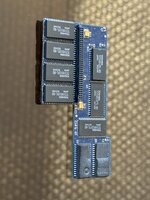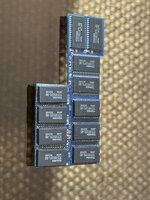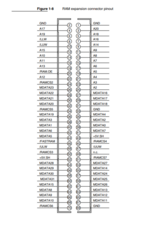TrueNorthStrong
Well-known member
In the continuing saga of the 180c I'm working on, I dove right in to tackling a memory expansion modification to get it up to that sweet 14MB limit.
The card is a 4MB expansion card but has all the pads for 10MB.
I wasn't able to source exact replacement chips, instead I found them in a standard SOP package (versus the TSOP that's on board standard).
This necessitated the legs to be folded under the chip and tacked on that way. There's a wax coating of sorts on the board edged which made soldering to those contacts rather tricky, but I believe I got it (sure ain't too pretty though).
I have not yet gotten to installing the filtering caps, but I wanted to see in this halfway state how the system would respond to it being installed. I get death chimes on boot, doesn't even manage to get to a dead mac screen to show any diagnostics.
So, I'd like to understand things at this stage so far:
- Are those caps strictly necessary for the card to function? Or, missing those, would it still manage to boot but not see the additional memory?
- Presumably the lines on each chip are commoned together or connect in some pattern to the connector. Does anyone know of a resource to refer to so I can confirm that all lines on all chips are actually connected correctly?
Any other tips about doing this work correctly would be great.
Thank you!
The card is a 4MB expansion card but has all the pads for 10MB.
I wasn't able to source exact replacement chips, instead I found them in a standard SOP package (versus the TSOP that's on board standard).
This necessitated the legs to be folded under the chip and tacked on that way. There's a wax coating of sorts on the board edged which made soldering to those contacts rather tricky, but I believe I got it (sure ain't too pretty though).
I have not yet gotten to installing the filtering caps, but I wanted to see in this halfway state how the system would respond to it being installed. I get death chimes on boot, doesn't even manage to get to a dead mac screen to show any diagnostics.
So, I'd like to understand things at this stage so far:
- Are those caps strictly necessary for the card to function? Or, missing those, would it still manage to boot but not see the additional memory?
- Presumably the lines on each chip are commoned together or connect in some pattern to the connector. Does anyone know of a resource to refer to so I can confirm that all lines on all chips are actually connected correctly?
Any other tips about doing this work correctly would be great.
Thank you!



